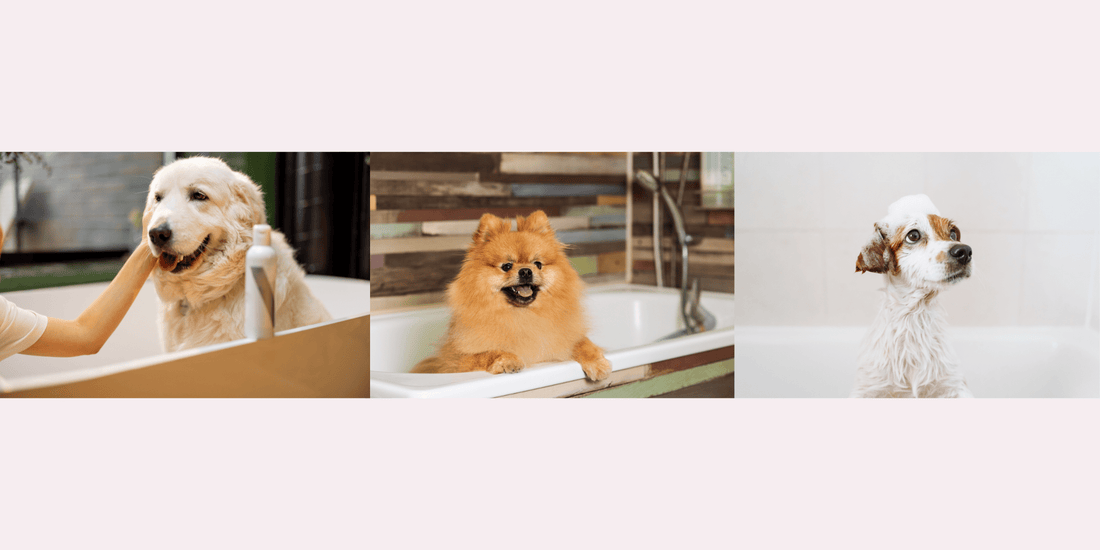How to turn washing into a pleasant experience?

For many owners, washing a dog is almost as challenging as trying to teach a cat to hop on one leg and recite the alphabet - but with the right approach and a few tricks, we can turn this experience into a pleasant ritual for both dog and owner.
The key to success? A calm approach, proper preparation, and plenty of patience! Of course, a generous supply of treats is a must-have.
Let's start with the preparation. Before you even take your dog to the bathroom, it's important to calm and relax them. A few minutes of petting, playing, or even a treat can do wonders. This will help your dog accept that something unusual is happening to them, especially if bathing is not one of their favorite activities.
Also, give your dog a good comb to remove any large dirt or knots and loose hair. Place a non-slip rubber mat or towel in the shower or bathtub to prevent slipping and provide greater stability.

The next step is the water temperature. No one likes the shock of cold water, so warm but not too hot water is the best choice. You can test it on your wrist – just like you would do on a baby. We need to be very careful with this, as puppies do not tolerate hot water well. WHY?
- Sensitive skin: Dogs' skin is thinner and more sensitive than humans', so it can easily burn or become irritated when exposed to hot water. Dogs don't have as thick a sweat gland as humans, which means their skin isn't as resistant to temperature changes.
- Coat Density: Dogs often have a double coat (undercoat and topcoat) which acts as natural insulation. When hot water hits their coat, the heat can be trapped close to the skin, creating a feeling of heat and discomfort.
- Poor thermoregulation: Dogs cool themselves primarily by panting and sweating through their paw pads, which is much less efficient than humans sweating throughout their entire body. The heat in the water can quickly overheat their bodies, causing them stress.
- Natural adaptation to colder temperatures: Dogs are adapted to a variety of outdoor temperatures, but most tolerate colder water better than hot water. Most dogs enjoy cool or slightly warm water, as it is closer to their normal body temperature.
First, wet the body and wash it well with dog shampoo. Pets should not be washed too often, as this can disrupt the natural balance of their skin and hair. If we want to wash our dog weekly, or even a few times a week, then we must make sure to use a shampoo made from natural ingredients. Natural shampoos do not contain aggressive detergents, alcohol derivatives and artificial aromas that can cause itching, allergies or hair loss.
Dogs have a particularly sensitive area around their eyes and ears, so do not directly water these areas. Wash your puppy's head with a damp cloth , and gently clean his ears with ear cleaning spray and cotton wool or a dry cloth. This is especially recommended for puppies with floppy ears, as they are more likely to harbor bacteria (bacteria thrive in closed, warm, and slightly humid spaces).
We must be careful to rinse the shampoo thoroughly , otherwise it can cause skin irritation and itching.
Praise and treats play a key role during and after the bath. If you reward your dog regularly and talk to him like he just won the Nobel Prize, he will associate bathing with positive feelings. A treat after each major step will let him know that this is an experience that ends well – and with a delicious treat! Don't skimp!
Once the bath is finished, it's time to dry off. Here we can let him "shake off" as much as he wants, as this is relaxing and natural for him. Then we dry him thoroughly with a towel, maybe even with a dryer - and of course, don't forget the last portion of treats.

If the washing is done calmly, patiently, and with a lot of positivity, it becomes an opportunity for bonding between owner and dog. Bathing can then become a ritual that the dog (and owner) anticipates with positive feelings and less resistance – which is definitely a success!
Resources
- https://www.wikihow.com/Bathe-a-Dog-in-a-Shower
- https://www.purina.co.uk/articles/dogs/health/daily-care/how-to-bathe-your-dog
- https://www.houndslounge.com/blog/top-8-tips-to-make-your-dog-baths-easier/
- https://www.rspcapetinsurance.org.au/pet-care/dog-care/dog-grooming-guide
- https://cleaning-hacks.sharkclean.co.uk/how-to-dry-a-dog/
